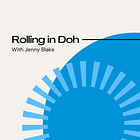🏖️The Formation of an Unlikely Hilderbabe, Part Two
Catch up on Part One first:
⛱️ The Formation of an Unlikely Hilderbabe, Part One
I scratched my head in anthropological confusion: Who are these mostly middle-aged women flocking to this island in pilgrimage to their favorite author? Where is Nantucket, again? Isn’t that one of those places fancy East Coast people “summer” as a verb? Who is this bronzed blonde bestselling author, “Queen of the Beach Read,” that, for some reason, I have never heard of?
Where we left off . . .

Who has the time to work out three hours a day?
Elin Hilderbrand, “Queen of the Beach Read,” who has produced thirty novels in as many years. But the seeming indulgence of her life-giving morning routine isn’t the only thing that caught my attention.
In part one, I shared the details of how she starts the day: five a.m. wake-up followed by food prep for the day, then a three-hour workout stack (Peloton cycling, jogging, barre class) that supports her writing.
“For me, [writing is] a job,” Hilderbrand says, “so I treat it like a job. I write every single day.”
“In the summer, I try to be at it by eleven, and I stay until six. I can write longhand and in notebooks, so I do it out by my pool.
When I say I write for seven hours, what I mean is that I’m trying to get three hours of composing done. So I give myself seven hours to compose for three.
I read—I’m always reading—and if I’m at my pool or the beach, I swim. I take a nap. I have my lunch. All of that’s happening.
But if you compose three hours a day, 350 days a year, you can write two books a year.”
These spacious routines give her time: for the last thirty years, she has produced at least one beach read every summer, and for seven of those years, she delivered two books per year, including one for the holidays—while raising four children.
“Getting on the Peloton is hard,” she told Kit Cooper, “but I always say to myself ‘this is the hardest thing you’re going to do today.’ [It’s] a discipline that sets up the rest of my day.”
Her productivity alone isn’t what I find most compelling. It’s the long view she has taken toward the arc of her writing career; her persistence, consistency, and patience.
Despite all the recent Swan Song publicity, Hilderbrand has been far from an overnight success.
Her first book advance was for $5,000, and she didn’t much enjoy working with her first publisher, whose strategy was to sign many authors, thus giving each scant attention and investment to minimize risk. They only printed 2,500 copies of her first book, which sold out and left readers hanging for three weeks while reprinting and restocking.1
As a result of the limited publisher investment, her first seven books experienced middling sales. Finally, Hilderbrand and her agent shopped for a new home for her annual beach reads, landing at Little, Brown.
Book by book, she continued climbing the charts.
But could she hit number one?
She did—at last—on her twenty-third try. As she shared on Eat the Damn Cake:
“That year, the person I had to beat to get to number one was Delia Owens, who wrote Where the Crawdads Sing, which had been number one for 49 weeks. And I’m like, ‘Can I catch her? Can I catch her?’”
Hilderbrand says she was feeling “a little bit bitter” because it was Owens’ first book, while she had been “slowly marching along,” only to watch this first-time novelist skyrocket to the top and stay there. But eventually, for one short glorious week, she reached that coveted top spot.
“It was very gratifying because that’s her first and only book—she was an overnight success,” Hilderbrand said. “And I had to work a little bit harder to get there. But that just goes to show that all that hard work completely paid off.”
As she tells Cooper of her second publisher:
“Little, Brown believed in me and they took a chance and put a lot of money in the marketing. But their growth pattern was slow and steady. And it was book by book, summer by summer, year by year, a little bit better every time.
It took thirteen years for me at Little, Brown to get from point A to point B, but I got to the top—and every book has debuted at number one since then.”
So what if other first-time novelists hit the New York Times list with their debut? She didn’t let compare-and-despair—or vanity metrics—slow her down.
Then again, she didn’t speed up, either. She kept delivering what she promised her publisher and community: one book every summer, still a superhuman feat.
Hilderbrand herself would be the first to say that it would have been fine if she never “hit the list.” She would have kept writing and working, because that’s the part she loves. “It was in my blood,” she said, continuing:
“It was my job. It was what I did. I did not have delusions of grandeur. I was happy that I was publishing books. I was happy even with my first five even when they weren’t doing well. I was frustrated because I felt like I wanted more readers . . . but I never considered quitting.”
Cliché as it may be, immersing myself in the Hilderverse reminded me to keep going. To ignore the odds. 51/49.
And that writing poolside, longhand on a legal pad, still counts as work.2
❤️
After completing her MFA at the University of Iowa’s writer’s workshop in 1998, she met her literary agent while in school. This led to her first book, The Beach Club, launching in the summer of 2000 with St. Martin’s Press.












I could relate to some of this. Not the exercising for three hours a day (Exercise, what exercise? Although I do feel inspired by your post to build a proper routine) but the things taking a loooong time and keeping plodding along. It took four self-published books and overall seventeen years for me to get a book deal, something I’d seen some people do with no books or after three weeks or a few months of writing online. That’s a lot of people to watch over that seventeen years. Clearly the universe was trying to teach me something in that process 🤣 And then I got the book deal when I’d actually let go of wanting it and was immersed in other things. And, well, you know the rest of that story 🤣 Now I’m at this point where I’m going back to base and what I love. Relearning not to care about all of that shite that consumed me for a while and knocked my confidence.